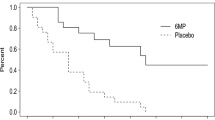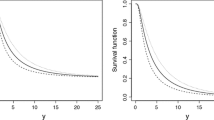Abstract
The purpose of this paper is to develop a Bayesian analysis for the right-censored survival data when immune or cured individuals may be present in the population from which the data is taken. In our approach the number of competing causes of the event of interest follows the Conway–Maxwell–Poisson distribution which generalizes the Poisson distribution. Markov chain Monte Carlo (MCMC) methods are used to develop a Bayesian procedure for the proposed model. Also, some discussions on the model selection and an illustration with a real data set are considered.
Similar content being viewed by others
References
Berkson J, Gage RP (1952) Survival curve for cancer patients following treatment. J Am Stat Assoc 47: 501–515
Boag JW (1949) Maximum likelihood estimates of the proportion of patients cured by cancer therapy. J R Stat Soc Ser B 11: 15–53
Chen MH, Ibrahim JG, Sinha D (1999) A new Bayesian model for survival data with a surviving fraction. J Am Stat Assoc 94: 909–919
Chen MH, Shao QM, Ibrahim J (2000) Monte Carlo methods in Bayesian computation. Springer, New York
Conway RW, Maxwell WL (1961) A queuing model with state dependent services rates. J Ind Eng XII: 132–136
Cooner F, Banerjee S, Carlin BP, Sinha D (2007) Flexible cure rate modeling under latent activation schemes. J Am Stat Assoc 102: 560–572
Cowles MK, Carlin BP (1996) Markov chain Monte Carlo convergence diagnostics: a comparative review. J Am Stat Assoc 91: 883–904
Gamerman D, Lopes HF (2006) Markov chain Monte Carlo: stochastic simulation for Bayesian inference, 2nd edn. Chapman & Hall/CRC, Boca Raton
Gelfand AE, Dey DK, Chang H (1992) Model determination using predictive distributions with implementation via sampling-based methods. In: Bayesian Statistics 4 (Peñíscola, 1991), Oxford Univ. Press, New York, pp 147–167
Gelman A, Rubin DB (1992) Inference from iterative simulation using multiple sequences. Stat Sci 7: 457–511
Gschlößl S, Czado C (2008) Modelling count data with overdispersion and spatial effects. Stat Pap 49: 531–552
Guikema SD, Coffelt JP (2008) A flexible count data regression model for risk analysis. Risk Anal 28: 213–223
Ibrahim JG, Chen MH, Sinha D (2001) Bayesian survival analysis. Springer, New York
Kadane JB, Shmueli G, Minka TP, Borle S, Boatwright P (2006) Conjugate analysis of the Conway-Maxwell-Poisson distribution. Bayesian Anal 1: 363–374
Kirkwood JM, Ibrahim JG, Sondak VK, Richards J, Flaherty LE, Ernstoff MS, Smith TJ, Rao U, Steele M, Blum RH (2000) High- and low-dose interferon alfa-2b in high-risk melanoma: first analysis of intergroup trial E1690/S9111/C9190. J Clin Oncol 18: 2444–2458
Kokonendji CC, Mizère D, Balakrishnan N (2008) Connections of the Poisson weight function to overdispersion and underdispersion. J Stat Plann Inference 138: 1287–1296
Lee DJ, Durban M (2009) Smooth–Car mixed models for spatial count data. Comput Stat Data Anal 53: 2968–2979
Lord D, Guikema SD, Geedipally SR (2008) Application of the Conway–Maxwell–Poisson generalized linear model for analyzing motor vehicle crashes. Accid Anal Prev 40: 1123–1134
Maller RA, Zhou X (1996) Survival analysis with long-term survivors. Wiley, New York
Nadarajah S (2009) Useful moment and CDF formulations for the COM-Poisson distribution. Stat Pap 50: 617–622
Rodrigues J, Cancho VG, de Castro M, Louzada-Neto F (2009a) On the unification of the long-term survival models. Stat Prob Lett 79: 753–759
Rodrigues J, de Castro M, Cancho VG, Balakrishnan N (2009b) COM–Poisson cure rate survival models and an application to a cutaneous melanoma data. J Stat Plann Inference 139: 3605–3611
Shmueli G, Minka TP, Kadane JB, Borle S, Boatwright P (2005) A useful distribution for fitting discrete data: revival of the Conway–Maxwell–Poisson distribution. J R Stat Soc Ser C 54: 127–142
Spiegelhalter DJ, Best NG, Carlin BP, van der Linde A (2002) Bayesian measures of model complexity and fit. J R Stat Soc Ser B 64: 583–639
Thomas A, O’Hara B, Ligges U, Sturtz S (2006) Making BUGS open. R News 6: 12–17
Tsodikov AD, Ibrahim JG, Yakovlev AY (2003) Estimating cure rates from survival data: an alternative to two-component mixture models. J Am Stat Assoc 98: 1063–1078
Yakovlev AY, Tsodikov AD (1996) Stochastic models of tumor latency and their biostatistical applications. World Scientific, Singapore
Author information
Authors and Affiliations
Corresponding author
Rights and permissions
About this article
Cite this article
Cancho, V.G., de Castro, M. & Rodrigues, J. A Bayesian analysis of the Conway–Maxwell–Poisson cure rate model. Stat Papers 53, 165–176 (2012). https://doi.org/10.1007/s00362-010-0326-5
Received:
Revised:
Published:
Issue Date:
DOI: https://doi.org/10.1007/s00362-010-0326-5
Keywords
- Survival analysis
- Cure rate models
- Long-term survival models
- Conway–Maxwell–Poisson (COM-Poisson) distribution
- Bayesian analysis
- Weibull distribution




